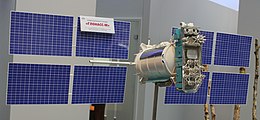
Summary
Kosmos 2516 (Russian: Космос 2516 meaning Space 2516) is a Russian military satellite launched in 2016 as part of the GLONASS satellite navigation system.
 Glonass-M satellite model | |
| Mission type | Navigation |
|---|---|
| Operator | Russian Aerospace Defence Forces |
| COSPAR ID | 2016-032A[1] |
| SATCAT no. | 41554[1] |
| Website | GLONASS status |
| Mission duration | Planned: 7 years Actual: 4 years, 5 months[2] |
| Spacecraft properties | |
| Spacecraft | GLONASS No. 753 |
| Spacecraft type | Uragan-M |
| Manufacturer | Reshetnev ISS[3] |
| Launch mass | 1,414 kilograms (3,117 lb) [3] |
| Dry mass | 250 kg[3] |
| Dimensions | 1.3 metres (4 ft 3 in) diameter [3] |
| Start of mission | |
| Launch date | May 29, 2016, 08:44 UTC |
| Rocket | Soyuz-2.1b/Fregat[3][4] |
| Launch site | Plesetsk 43/4 |
| Contractor | Russian Aerospace Defence Forces |
| End of mission | |
| Last contact | November 2020[2] |
| Orbital parameters | |
| Reference system | Geocentric |
| Regime | Medium Earth orbit |
| Semi-major axis | 25,508 km (15,850 mi)[1] |
| Eccentricity | 0.0011362[1] |
| Perigee altitude | 19,159 km (11,905 mi)[1] |
| Apogee altitude | 19,101 km (11,869 mi)[1] |
| Inclination | 64.70 degrees[1] |
| Period | 675.7 minutes[1] |
| Epoch | 30 January 2017 |
This satellite is a GLONASS-M satellite, also known as Uragan-M, and is numbered Uragan-M No. 753.[4]
Kosmos 2516 was launched from Site 43/4 at Plesetsk Cosmodrome in northern Russia. A Soyuz-2-1b carrier rocket with a Fregat upper stage was used to perform the launch which took place at 08:44 UTC on 29 May 2016. The launch successfully placed the satellite into a Medium Earth orbit. It subsequently received its Kosmos designation, and the international designator 2016-032A. The United States Space Command assigned it the Satellite Catalog Number 41554.[1]
The satellite is in orbital plane 2, in orbital slot 11.[5]
Kosmos 2516 experienced a depressurization event in November 2020, which permanently disabled the satellite after four years in service. GLONASS-K 15 (No. 705), launched on 25 October 2020, was repurposed as its replacement.[2]
See also edit
References edit
- ^ a b c d e f g h i "LIVE REAL TIME SATELLITE TRACKING AND PREDICTIONS: COSMOS 2516 (GLONASS)". n2yo.com. Retrieved January 30, 2017.
- ^ a b c "Новейший "Глонасс-К" сменит вышедший из строя аппарат, рассказал источник" [Newest Glonass-K to replace failed satellite, source says]. RIA Novosti (in Russian). December 26, 2020. Retrieved December 27, 2020.
- ^ a b c d e Anatoly Zak. "GLONASS network". RussiaSpaceWeb.com. Retrieved January 30, 2017.
- ^ a b Stephen Clark (May 31, 2016). "Russia's navigation network receives new satellite". Spaceflight Now. Retrieved January 30, 2017.
- ^ "GLONASS constellation status, 30.01.2017". Information-analytical centre, Korolyov, Russia. January 30, 2017. Archived from the original on June 19, 2017. Retrieved January 30, 2017.


